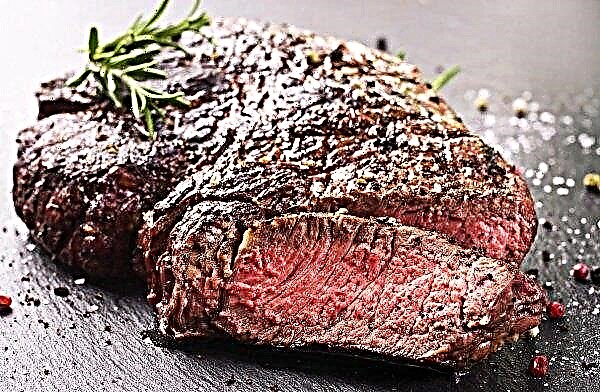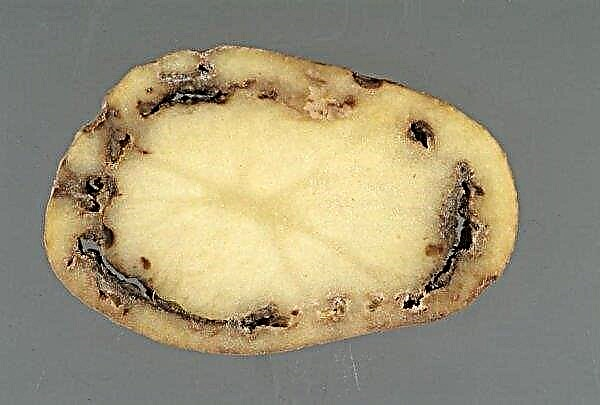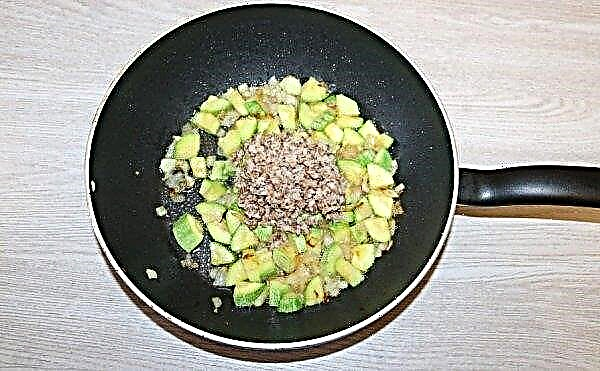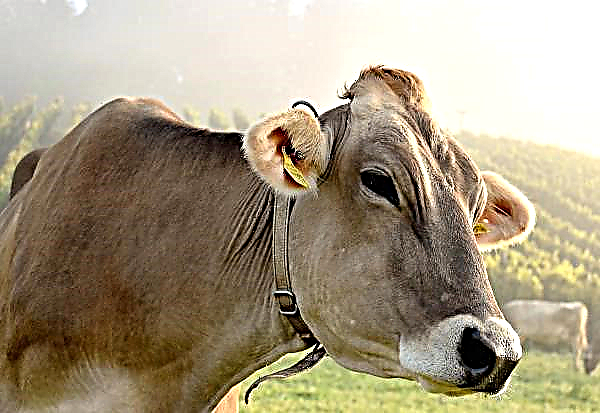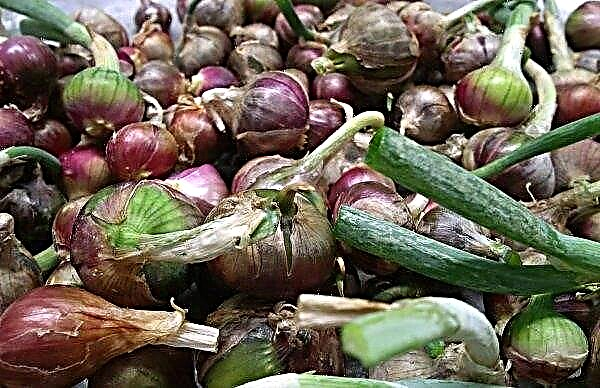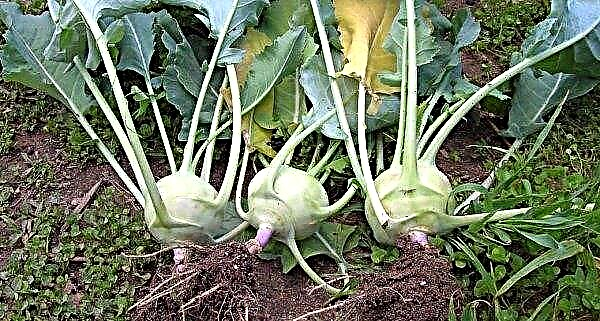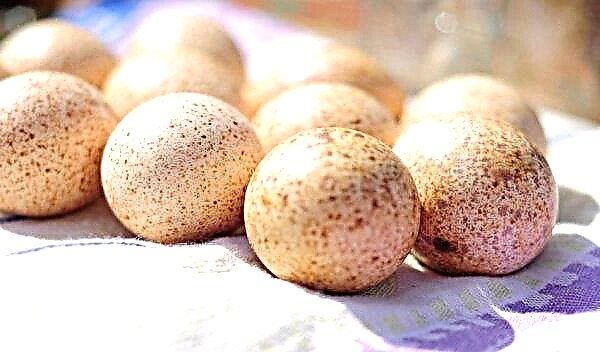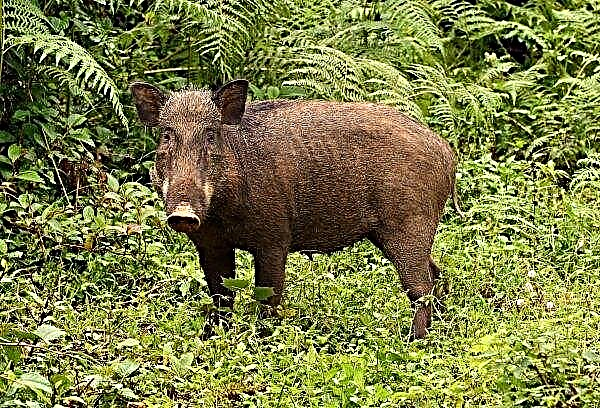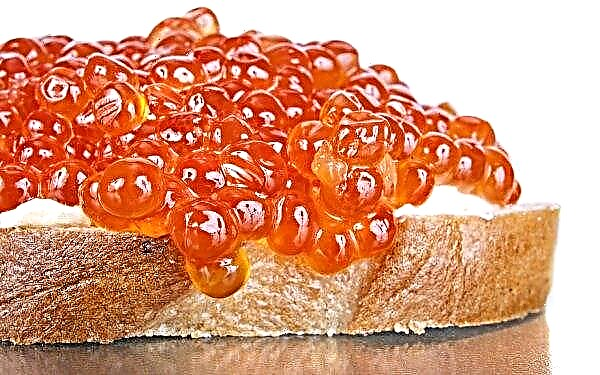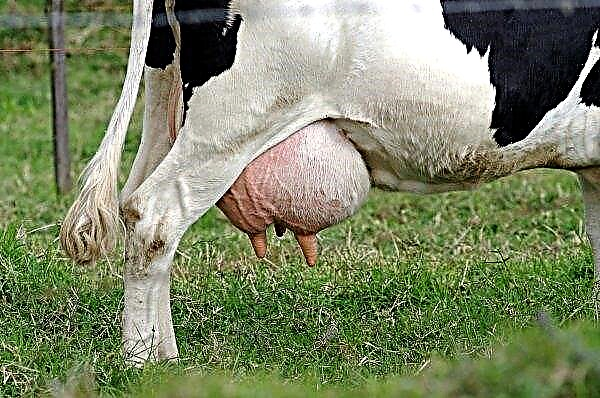Onions are grown in almost every suburban area and garden. This vegetable has a number of useful qualities, it is used to prepare many dishes, and is well stored throughout the winter. However, in order for it to lie for a long time, it must be placed in optimal conditions and properly prepared for storage.
Did you know? The ancient Greek historian Herodotus, who lived 2500 years ago, wrote that one of the largest Egyptian pyramids in Giza - Cheops - there was an inscription that indicated how much garlic and onion was spent on food by the workers who built it.
When and how to remove onions from the beds
So that the onion can be stored for a long time, it must be removed in a timely manner. The observance of the correct deadlines determines the level of the crop, its quality and duration of laying. If the bulbs are removed too early, pathogens can enter the still thick and open neck. And late harvested fruits re-grow roots, which also makes them vulnerable to disease. The timing of the vegetable’s readiness for harvesting can be determined by external signs, using mathematical calculations or by the lunar calendar.
There are 3 external signs by which gardeners determine that bulbs can be dug up and stored:
- the stems were yellowed, dried up and laid down on the ground;
- become thin and dry the necks of the bulbs;
- the top layer of the peel on the heads has dried out.
If the summer turned out to be cool and humid, then external signs can cause doubt - for example, feathers do not turn yellow and do not lie down. Therefore, the cleaning day can be calculated using simple mathematical calculations. To do this, add 90-150 days to the date of planting the vegetable. How many days you need to add depends on the planted variety or hybrid.
Important! According to the lunar calendar, it is not recommended to remove vegetables from the garden, including onions, in the full moon.
So, early-ripening varieties need to be harvested after 90 days, mid-ripening - after 120, mid-late - after 140, late - after 150. Some gardeners calculate the preparedness of the vegetable for harvesting, using the lunar calendar. All vegetables that grow underground are recommended to be harvested when the moon is in a waning phase. It is believed that it was at this time that the plant juices were sent to the bulb, but after the new moon they rush into the stem. Harvesting should begin when 60–80% of the stems have died. Cleaning should be completed in 10 days.
Onions are harvested in two ways:
- manual;
- mechanized.
 If the soil is loose, then the fruits are carefully pulled out by the feathers with your hands. When harvesting on heavy soils, a shovel or pitchfork will be required. These tools make easy digging of the heads. The mechanized method is used to collect large volumes of the crop. For this, special onion harvesting complexes are used.
If the soil is loose, then the fruits are carefully pulled out by the feathers with your hands. When harvesting on heavy soils, a shovel or pitchfork will be required. These tools make easy digging of the heads. The mechanized method is used to collect large volumes of the crop. For this, special onion harvesting complexes are used.Features of Onion Drying
Before placing the dug onions for storage, it is necessary to carry out pre-harvest preparation - carefully dry the bulbs, trim the roots and feathers.
Did you know? In 1985, it was possible to decipher the first cookbooks, which were made in the form of clay tablets and written 4 thousand years ago. They contained information that the inhabitants of Ancient Mesopotamia ate onions, leeks, shallots and garlic.
Sevka
After harvesting, the seeds are laid out in a thin layer on the canvas and placed in the sun. Periodically, it is turned over, exposing the sun's rays to different sides of the bulbs. The duration of drying in the open must be at least 3 days. Then, for 1–2 weeks, you can transfer the sevc under a canopy or in a well-ventilated room with a temperature of about + 30 ° C. Drying is allowed for 7–10 days only under sunlight.
Onion
You can dry onions in several ways:
- Spread in a single layer in the sun, periodically turning the heads for uniform drying.
- Place the bulbs in a well-ventilated area. You can put them in nets or hang them from the ceiling.
- Weave into bundles, braids and hang under a canopy.
Chernushki
Onion seeds, which are also called chernoshka for their black color, are dried in 3 stages:
- The first week after cleaning, they keep it in a room with good ventilation at a temperature of + 20 ° C.
- The second week create conditions with a temperature regime of + 30 ° C.
- In the third week, the air temperature is increased to + 35 ° C.

How to dry onions for the winter at home
If the onion crop was successful, but there are no large rooms for storing it, the natural question that arises in this case is whether it is possible to save the heads and at the same time save space. This can be done if you dry the onions with household appliances or in the open. First, it needs to be cleaned, washed and dried, and then cut into rings, half rings or small cubes. Sliced pieces should be 3-5 mm thick. After drying, about 100–120 g of dried product will be released from 1 kg of fresh product.
Important! In the open air, onions can only be dried in case of sunny warm weather. During rains, grills should be brought into a well-ventilated area.
In the oven
The technology for drying chopped onions in the oven looks like this:
- Preheat the oven to a temperature of + 50 ... + 60 ° С.
- Cover the baking sheet with parchment.
- Lay onion chopped onion in one layer.
- Place the pan in the oven.
- The oven lid must not be completely closed.
- Bulbs should be dried for 5-6 hours, green onions for 3-4 hours.

In the electric dryer
In an electric dryer, the vegetable is dried at a temperature of + 55 ... + 65 ° C for 7 hours. The lid is not completely closed during drying. The drying process can be shortened by pre-boiling the chopped vegetable in water for 3-4 minutes.
In the air grill
Significantly reduce the drying time allows the use of air grill. It needs to set the temperature + 70 ° C. The duration of the procedure is 1 hour.
On air
For those who do not have the above devices, there is also a way out - onions can simply be dried in the fresh air.
Do this as follows:
- Spread sliced vegetables in a single layer on wire mesh.
- Grids can be covered with gauze to protect them from insects.
- Place the grilles in a shaded, well-blown place.
- Every day, the onions must be stirred so that drying occurs evenly.
- In this state, the vegetable is kept until completely dry.

Signs of a well-dried bulb
So, we learned how to dry onions for the winter at home. We suggest you familiarize yourself with the signs that the vegetable has been dried correctly:
- the vegetable has become fragile;
- he is crunching;
- its color is light yellow;
- the taste is not felt sharp;
- there was a spicy smack.
Terms and rules of storage of dried onions
Dried vegetables should be stored in linen bags, glass jars with a lid or cardboard boxes. They are placed in a dark, damp place where no odors are observed. The shelf life of the dried product is 1 year.
Possible storage problems
After the vegetable is stored, it must be inspected periodically. It is important that he stands in recommended conditions. If you put containers with dried onions in the sun, it will quickly lose most of its valuable substances.
When stored in a room with high humidity, the pieces will no longer be crispy. If the place where the product is stored is poorly ventilated, then insects can start in it and it will be completely damaged. When stored in a jar with a tightly closed lid, onion rings will become soft. You should choose a perforated cover made of plastic, which is good for air permeability. If this is not the case, then paper or gauze is suitable, folded in several layers and fixed on the neck of a glass container.
When stored in a jar with a tightly closed lid, onion rings will become soft. You should choose a perforated cover made of plastic, which is good for air permeability. If this is not the case, then paper or gauze is suitable, folded in several layers and fixed on the neck of a glass container.
Thus, in order to prepare onions for the winter, it is enough to know how to properly harvest it, prepare it for storage and, in fact, store it. To save space, you can dry the vegetable. In this form, it will be stored longer, and it will be easier to use it when cooking dishes.

